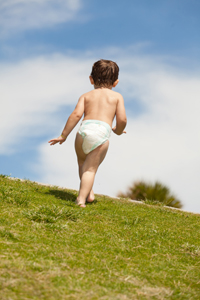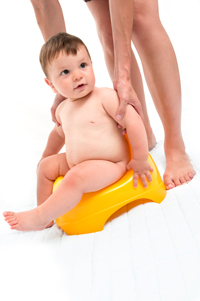What is the right toilet training age?
It’s hard to say
It is no secret that, as parents, we love to be proud of our children and what they can do at an early age. Having your child walking or stringing words together, amongst other things, is something we love to share with family and friends.

It is impossible to set an exact age to start toilet training. Some children are ready at 18 months, some not until 2 years or even later.
Boys and girls also develop with respect to toilet training at different rates, with girls generally being toilet trained earlier than boys. Whether early or late, you’ll notice that a number of trends begin to come together.
Developmental stages
Children all go through developmental stages in their own time and shouldn’t be rushed, just because a cousin or friend is doing something your little girl or boy is not. Do not put yourself or your child under pressure, and if you are concerned, rather seek help from a medical professional.
The same applies to toilet training. Knowing when to start toilet training is half the “battle”.
Read up and understand the science behind the process of toilet training, so that you have a good understanding of each phase, what you should be doing and what your child should be doing, and this will help you will feel prepared for whatever comes your way. Remember knowledge is power and Huggies Pull-Ups® are the Champions of Learning.
When to start toilet training
There is no “right age” to start toilet training; it depends on where your child is at physically, emotionally and psychologically.
Unless you are a trained medical professional or have done this before, knowing when your child is ready to start using the toilet can be tricky, especially if you are not sure what to look out for.
Signs of readiness
Don’t fear. By watching your child’s behaviour, you might notice little hints that are often referred to as the signs of readiness:
- Their diaper is dryer for longer periods of time; this shows that their bladder and bowel control is improving.
- Your child says wee or poo during a diaper change and understands what they are.
- Your child has the dexterity to pull their pants up and down.
- Your child recognises the urge to go, by using facial expressions, holding onto themselves or making noises.
- Your toddler can understand what you’re saying and follow simple instructions.
- Your toddler is able to walk and can sit on a potty or toilet.
- Your child understands the meaning of wet and dry.
More on toilet training age
Once you have identified the signs of readiness, prepared yourself, and set a time, it’s go, go, go…
Think of yourself as their coach, teaching by example, encouraging, using tools to help motivate them and monitoring progress, as well as adjusting your approach as you find what works and what doesn’t work. Remember, each child is different, and the more you understand the process and know what to do, the better for both of you.
As with anything, introducing your toddler to something new may have a positive or negative response. Try to get them engaged and excited, and always remember that there are very few teenagers in diapers. They will get there, eventually.
Remember, toilet training age varies
If your child refuses to co-operate with you, don’t try to force it like a puzzle that won’t fit, maybe your child is not ready. Try some different approaches and, if there is still no interest or cooperation, be patient. Make sure your child is in fact ready.
The worst thing a parent can do is to become frustrated and start using discipline as a toilet training approach. This will in most cases have a negative impact on your toilet training efforts. Punishing your child for accidents will get you nowhere.
Stay cool, calm and collected and know that this may take time. Rome wasn’t built in a day, and your child is unlikely to be toilet trained in a day or two either. Some children take just a few weeks, while others can take months before they get the hang of it.
Early toilet training preparation
If your child shows interest in what you are doing in the bathroom, don’t shoosh them out, encourage their curiosity by letting them watch you on the toilet. Sometimes it’s a good time to interact with them as well.
Toddlers learn by watching you, their siblings and friends. Seeing you use the toilet can begin the early preparation for toilet training. Enough watching and getting them onto a potty or toilet seat becomes a natural progression, with which they are familiar.
In addition to socialising them with toilet time, make sure you have the right products and tools to support your toilet training efforts. Letting them choose their potty, getting them involved, and letting them know they are a “Big Kid” now is all part of the process.
Don’t be discouraged when toilet training your child

Remember, if your first attempts are disappointing, or if your child starts out fine then regresses, don’t dwell on it. The key is to make sure your child is ready to start, and to find an approach that works for you and your child.
Consider delaying the start of toilet training if a big change is about to happen, such as moving house or if a new baby is on the way. While you may make some progress these big changes can very often also result in regression.

